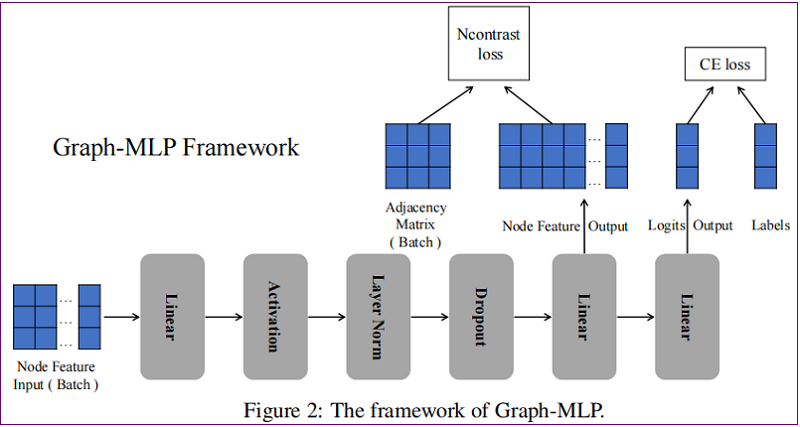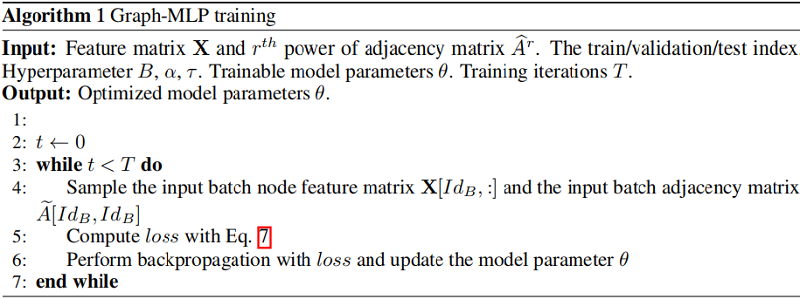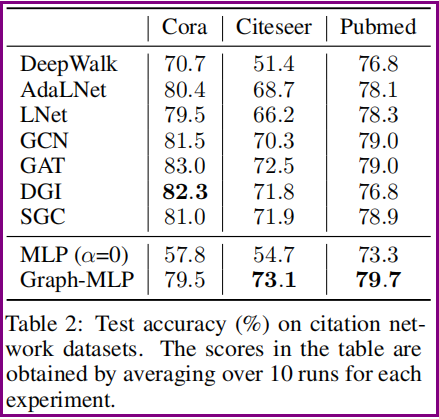论文解读(Graph-MLP)《Graph-MLP: Node Classification without Message Passing in Graph》
论文信息
论文标题:Graph-MLP: Node Classification without Message Passing in Graph
论文作者:Yang Hu, Haoxuan You, Zhecan Wang, Zhicheng Wang,Erjin Zhou, Yue Gao
论文来源:2021, ArXiv
论文地址:download
论文代码:download
1 Introduction
本文工作:
不使用基于消息传递模块的GNNs,取而代之的是使用Graph-MLP:一个仅在计算损失时考虑结构信息的MLP。
任务:节点分类。在这个任务中,将由标记和未标记节点组成的图输入到一个模型中,输出是未标记节点的预测。
2 Method
2.1 Graph-MLP
整体框架如下:


class GMLP(nn.Module):
def __init__(self, nfeat, nhid, nclass, dropout):
super(GMLP, self).__init__()
self.nhid = nhid
self.mlp = Mlp(nfeat, self.nhid, dropout)
self.classifier = Linear(self.nhid, nclass)
def forward(self, x):
Z = self.mlp(x)
if self.training:
x_dis = get_feature_dis(Z)
class_feature = self.classifier(Z)
class_logits = F.log_softmax(class_feature, dim=1)
if self.training:
return class_logits, x_dis
else:
return class_logits
2.1.1 MLP-based Structure
结构: linear-activation-layer normalization-dropout-linear-linear
即:
$\begin{array}{c} \mathbf{X}^{(1)}=\text { Dropout }\left(L N\left(\sigma\left(\mathbf{X} W^{0}\right)\right)\right) \quad\quad\quad(3)\\ \mathbf{Z}=\mathbf{X}^{(1)} W^{1} \quad\quad\quad(4)\\ \mathbf{Y}=\mathbf{Z} W^{2}\quad\quad\quad(5) \end{array}$
其中:$Z$ 用于 NConterast 损失,$ Y$ 用于分类损失。
2.1.2 Neighbouring Contrastive Loss
在 NContast 损失中,认为每个节点的 $\text{r-hop}$ 邻居为正样本,其他节点为负样本。这种损失鼓励正样本更接近目标节点,并根据特征距离推动负样本远离目标节点。采样 $B$ 个邻居,第 $i$ 个节点的 NContrast loss 可以表述为:
${\large \ell_{i}=-\log \frac{\sum\limits _{j=1}^{B} \mathbf{1}_{[j \neq i]} \gamma_{i j} \exp \left(\operatorname{sim}\left(\boldsymbol{z}_{i}, \boldsymbol{z}_{j}\right) / \tau\right)}{\sum\limits _{k=1}^{B} \mathbf{1}_{[k \neq i]} \exp \left(\operatorname{sim}\left(\boldsymbol{z}_{i}, \boldsymbol{z}_{k}\right) / \tau\right)}} \quad\quad\quad(6)$
其中:$\gamma_{i j} $ 表示节点 $i$ 和节点 $j$ 之间的连接强度,这里定义为 $\gamma_{i j}=\widehat{A}_{i j}^{r}$。
$\gamma_{i j}$ 为非 $0$ 值当且仅当结点 $j$ 是结点 $i$ 的 $r$ 跳邻居,即:
$\gamma_{i j}\left\{\begin{array}{ll}=0, & \text { node } j \text { is the } r \text {-hop neighbor of node } i \\\neq 0, & \text { node } j \text { is not the } r \text {-hop neighbor of node } i \end{array}\right.$

#计算特征相似度
def get_feature_dis(x):
"""
x : batch_size x nhid
x_dis(i,j): item means the similarity between x(i) and x(j).
"""
x_dis = x@x.T
x_sum = torch.sum(x**2, 1).reshape(-1, 1)
x_sum = torch.sqrt(x_sum).reshape(-1, 1)
x_sum = x_sum @ x_sum.T
#标准化
x_dis = x_dis*(x_sum**(-1))
mask = torch.eye(x_dis.shape[0]).cuda(1)
x_dis = (1-mask) * x_dis
return x_dis
#定义 Ncontrast 损失函数
def Ncontrast(x_dis, adj_label, tau = 1):
#分子计算
x_dis = torch.exp( tau * x_dis)
x_dis_sum_pos = torch.sum(x_dis * adj_label, 1)
#分母计算
x_dis_sum = torch.sum(x_dis, 1)
#求平均
# loss = -torch.log(x_dis_sum_pos * (x_dis_sum**(-1))+1e-8).mean()
loss = -torch.log(x_dis_sum_pos * (x_dis_sum+1e-8) ** (-1)).mean()
return loss
总 NContrast loss 为 $loss_{NC}$,而分类损失采用的是传统的交叉熵(用 $loss_{CE}$ 表示 ),因此上述 Graph-MLP 的总损失函数如下:
$\begin{aligned}\operatorname{loss}_{NC} &=\alpha \frac{1}{B} \sum\limits _{i=1}^{B} \ell_{i}\quad\quad\quad(7)\\\text { loss }_{\text {final }} &=\operatorname{loss}_{C E}+\operatorname{loss}_{N C}\quad\quad\quad(8) \end{aligned}$

def train():
#获取Batch中的邻接矩阵和特征矩阵
features_batch, adj_label_batch = get_batch(batch_size=args.batch_size)
model.train()
optimizer.zero_grad()
output, x_dis = model(features_batch)
loss_train_class = F.nll_loss(output[idx_train], labels[idx_train]) #分类损失
loss_Ncontrast = Ncontrast(x_dis, adj_label_batch, tau = args.tau) #邻居对比损失
loss_train = loss_train_class + loss_Ncontrast * args.alpha
acc_train = accuracy(output[idx_train], labels[idx_train])
loss_train.backward()
optimizer.step()
return
2.1.3 Training
对用 Neighbouring Contrastive Loss 采用大小为 $B$ 的 batch 进行训练,对于分类损失按照本监督节点分类的设置进行计算。
算法如 Algorithm 1 所示:

本文 Graph-MLP 输入的仅有属性信息,不依赖与结构信息,所以当结构信息发生变化时,Graph-MLP 仍然可以提供一致可靠的结果。
3 Experiment
数据集

节点分类

Graph-MLP 与 GNN 的效率对比

关于超参数的消融术研究

可视化

鲁棒性
为了证明Graph-MLP在缺失连接下进行推断仍具有良好的鲁棒性,作者在测试过程中的邻接矩阵中添加了噪声,缺失连接的邻接矩阵的计算公式如下:
$A_{\text {corr }}=A \otimes mask +(1- mask ) \otimes \mathbb{N} \quad\quad\quad(9)$
$\operatorname{mask}\left\{\begin{array}{ll} =1, & p=1-\delta \\ =0, & p=\delta \end{array}\right.\quad\quad\quad(10)$
其中 $\delta$ 表示缺失率,$mask \in n \times n$ 决定邻接矩阵中缺失的位置,$mask$ 中的元素取 $1 / 0$ 的概率为 $1-\delta / \delta$ 。 $\mathbb{N} \in n \times n$ 中的元素取 $1 / 0$ 的 概率都为 $0.5$ 。

结论:从上图可以看出随着缺失率的增加,GCN的推断性能急剧下降,而Graph-MLP却基本不受影响。
4 Conclusion
提出邻居对比损失,输入仅依赖于属性信息,并不依赖结构信息。
修改历史
2022-04-02 创建文章
2022-06-12 精读
因上求缘,果上努力~~~~ 作者:图神经网络,转载请注明原文链接:https://www.cnblogs.com/BlairGrowing/p/16093227.html



